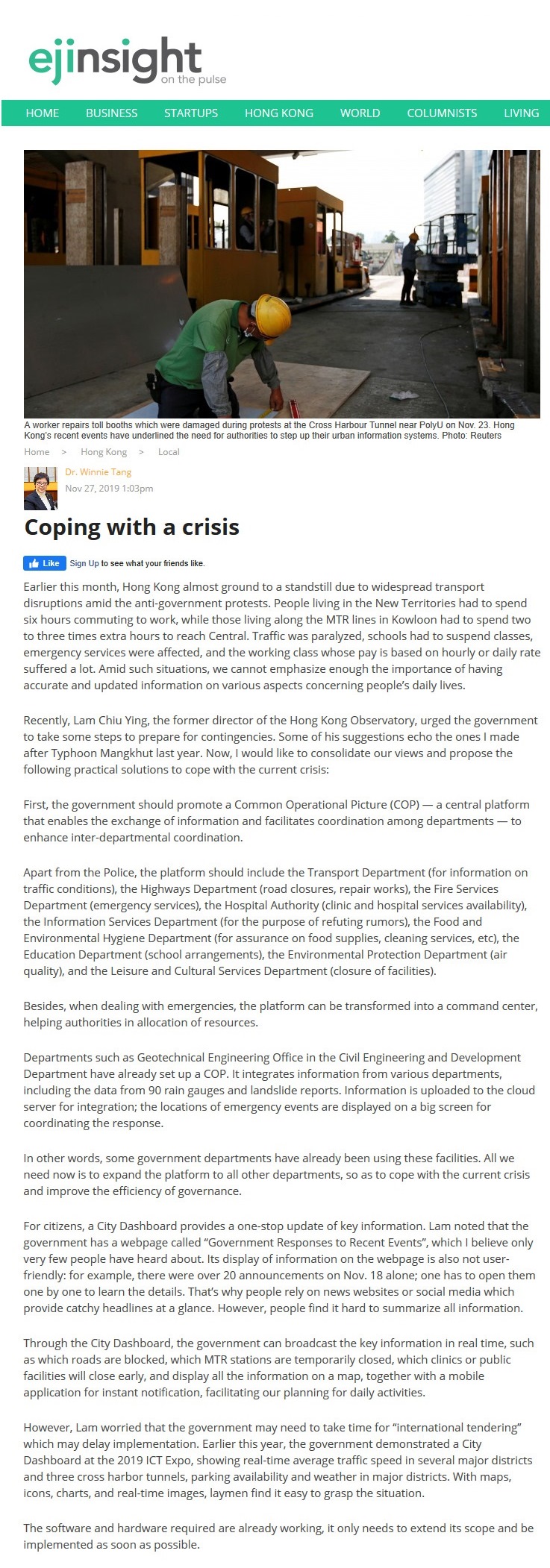網上版請按此

Coping with a crisis
Earlier this month, Hong Kong almost ground to a standstill due to widespread transport disruptions amid the anti-government protests. People living in the New Territories had to spend six hours commuting to work, while those living along the MTR lines in Kowloon had to spend two to three times extra hours to reach Central. Traffic was paralyzed, schools had to suspend classes, emergency services were affected, and the working class whose pay is based on hourly or daily rate suffered a lot. Amid such situations, we cannot emphasize enough the importance of having accurate and updated information on various aspects concerning people's daily lives.
Recently, Lam Chiu Ying, the former director of the Hong Kong Observatory, urged the government to take some steps to prepare for contingencies. Some of his suggestions echo the ones I made after Typhoon Mangkhut last year. Now, I would like to consolidate our views and propose the following practical solutions to cope with the current crisis:
First, the government should promote a Common Operational Picture (COP) — a central platform that enables the exchange of information and facilitates coordination among departments — to enhance inter-departmental coordination.
Apart from the Police, the platform should include the Transport Department (for information on traffic conditions), the Highways Department (road closures, repair works), the Fire Services Department (emergency services), the Hospital Authority (clinic and hospital services availability), the Information Services Department (for the purpose of refuting rumors), the Food and Environmental Hygiene Department (for assurance on food supplies, cleaning services, etc), the Education Department (school arrangements), the Environmental Protection Department (air quality), and the Leisure and Cultural Services Department (closure of facilities).
Besides, when dealing with emergencies, the platform can be transformed into a command center, helping authorities in allocation of resources.
Departments such as Geotechnical Engineering Office in the Civil Engineering and Development Department have already set up a COP. It integrates information from various departments, including the data from 90 rain gauges and landslide reports. Information is uploaded to the cloud server for integration; the locations of emergency events are displayed on a big screen for coordinating the response.
In other words, some government departments have already been using these facilities. All we need now is to expand the platform to all other departments, so as to cope with the current crisis and improve the efficiency of governance.
For citizens, a City Dashboard provides a one-stop update of key information. Lam noted that the government has a webpage called "Government Responses to Recent Events", which I believe only very few people have heard about. Its display of information on the webpage is also not user-friendly: for example, there were over 20 announcements on Nov. 18 alone; one has to open them one by one to learn the details. That's why people rely on news websites or social media which provide catchy headlines at a glance. However, people find it hard to summarize all information.
Through the City Dashboard, the government can broadcast the key information in real time, such as which roads are blocked, which MTR stations are temporarily closed, which clinics or public facilities will close early, and display all the information on a map, together with a mobile application for instant notification, facilitating our planning for daily activities.
However, Lam worried that the government may need to take time for "international tendering" which may delay implementation. Earlier this year, the government demonstrated a City Dashboard at the 2019 ICT Expo, showing real-time average traffic speed in several major districts and three cross harbor tunnels, parking availability and weather in major districts. With maps, icons, charts, and real-time images, laymen find it easy to grasp the situation.
The software and hardware required are already working, it only needs to extend its scope and be implemented as soon as possible.
Dr. Winnie Tang
Adjunct Professor, Department of Computer Science, Faculty of Engineering and Faculty of Architecture, The University of Hong Kong